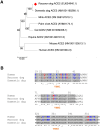Structural basis for raccoon dog receptor recognition by SARS-CoV-2
- PMID: 38709834
- PMCID: PMC11098500
- DOI: 10.1371/journal.ppat.1012204
Structural basis for raccoon dog receptor recognition by SARS-CoV-2
Abstract
Since the COVID-19 outbreak, raccoon dogs have been suggested as a potential intermediary in transmitting SARS-CoV-2 to humans. To understand their role in the COVID-19 pandemic and the species barrier for SARS-CoV-2 transmission to humans, we analyzed how their ACE2 protein interacts with SARS-CoV-2 spike protein. Biochemical data showed that raccoon dog ACE2 is an effective receptor for SARS-CoV-2 spike protein, though not as effective as human ACE2. Structural comparisons highlighted differences in the virus-binding residues of raccoon dog ACE2 compared to human ACE2 (L24Q, Y34H, E38D, T82M, R353K), explaining their varied effectiveness as receptors for SARS-CoV-2. These variations contribute to the species barrier that exists between raccoon dogs and humans regarding SARS-CoV-2 transmission. Identifying these barriers can help assess the susceptibility of other mammals to SARS-CoV-2. Our research underscores the potential of raccoon dogs as SARS-CoV-2 carriers and identifies molecular barriers that affect the virus's ability to jump between species.
Copyright: © 2024 Hsueh et al. This is an open access article distributed under the terms of the Creative Commons Attribution License, which permits unrestricted use, distribution, and reproduction in any medium, provided the original author and source are credited.
Conflict of interest statement
The authors have declared that no competing interests exist.
Figures





Similar articles
-
Receptor binding and structural basis of raccoon dog ACE2 binding to SARS-CoV-2 prototype and its variants.PLoS Pathog. 2024 Dec 5;20(12):e1012713. doi: 10.1371/journal.ppat.1012713. eCollection 2024 Dec. PLoS Pathog. 2024. PMID: 39637248 Free PMC article.
-
SARS-CoV-2 spike protein favors ACE2 from Bovidae and Cricetidae.J Med Virol. 2020 Sep;92(9):1649-1656. doi: 10.1002/jmv.25817. Epub 2020 Apr 10. J Med Virol. 2020. PMID: 32239522 Free PMC article.
-
Angiotensin-converting enzyme 2 (ACE2) from raccoon dog can serve as an efficient receptor for the spike protein of severe acute respiratory syndrome coronavirus.J Gen Virol. 2009 Nov;90(Pt 11):2695-2703. doi: 10.1099/vir.0.013490-0. Epub 2009 Jul 22. J Gen Virol. 2009. PMID: 19625462
-
Contributions of human ACE2 and TMPRSS2 in determining host-pathogen interaction of COVID-19.J Genet. 2021;100(1):12. doi: 10.1007/s12041-021-01262-w. J Genet. 2021. PMID: 33707363 Free PMC article. Review.
-
Host Cell and SARS-CoV-2-Associated Molecular Structures and Factors as Potential Therapeutic Targets.Cells. 2021 Sep 15;10(9):2427. doi: 10.3390/cells10092427. Cells. 2021. PMID: 34572076 Free PMC article. Review.
Cited by
-
Molecular Evidence of Raccoon Dog (Nyctereutes procyonoides) as a Natural Definitive Host for Several Sarcocystis Species.Pathogens. 2025 Mar 15;14(3):288. doi: 10.3390/pathogens14030288. Pathogens. 2025. PMID: 40137773 Free PMC article.
-
SARS-CoV-2 spike protein: structure, viral entry and variants.Nat Rev Microbiol. 2025 Jul;23(7):455-468. doi: 10.1038/s41579-025-01185-8. Epub 2025 May 6. Nat Rev Microbiol. 2025. PMID: 40328900 Review.
-
Receptor binding and structural basis of raccoon dog ACE2 binding to SARS-CoV-2 prototype and its variants.PLoS Pathog. 2024 Dec 5;20(12):e1012713. doi: 10.1371/journal.ppat.1012713. eCollection 2024 Dec. PLoS Pathog. 2024. PMID: 39637248 Free PMC article.
-
Discovery of Nanosota-9 as anti-Omicron nanobody therapeutic candidate.PLoS Pathog. 2024 Nov 26;20(11):e1012726. doi: 10.1371/journal.ppat.1012726. eCollection 2024 Nov. PLoS Pathog. 2024. PMID: 39591462 Free PMC article.
References
MeSH terms
Substances
Grants and funding
LinkOut - more resources
Full Text Sources
Medical
Research Materials
Miscellaneous

